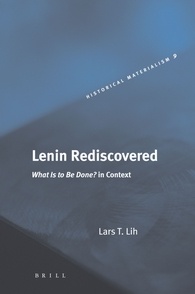Lars T. Lih
Lenin’s What is to Be Done? (1902) has long been seen as the founding document of a ‘party of a new type’. For some, it provided a model of ‘vanguard party’ that was the essence of Bolshevism, for others it manifested Lenin’s élitist and manipulatory attitude towards the workers.
This substantial new commentary, based on contemporary Russian- and German-language sources, provides hitherto unavailable contextual information that undermines these views and shows how Lenin’s argument rests squarely on an optimistic confidence in the workers’ revolutionary inclinations and on his admiration of German Social Democracy in particular. Lenin’s outlook cannot be understood, Lih claims here, outside the context of international Social Democracy, the disputes within Russian Social Democracy and the institutions of the revolutionary underground.
The new translation focuses attention on hard-to-translate key terms. This study raises new and unsettling questions about the legacy of Marx, Bolshevism as a historical force, and the course of Soviet history, but, most of all, it will revolutionise the conventional interpretations of Lenin.
Biographical note
Reviews
–Paul Blackledge, International Socialism
“Extraordinary and extraordinarily welcome.”
— John Molyneux
“A magnificent contribution to our understanding of V.I. Lenin, Bolshevism, Marxism, and the history of the Russian revolutionary movement and of Communism.”
— Paul LeBlanc
“Historians of the Russian Revolution owe a great debt to Lars Lih. The new textbook on the formative years of Bolshevism is much more convincing than the old version.”
— Kevin Murphy
“An important advance in the historiography of classical Marxism”
— Alan Shandro, Science & Society 73/ 4, (October 2009), 556-9
[…] Lih’s arguments are important to the modern left.
weeklyworker, Issue 638, 30 August 2006
“Lars T. Lih hat sich mit seinem voluminösen Buch die Aufgabe gestellt, der Entstehung und dem Kontext von Lenins Schrift gerecht zu werden und die gängige Meinung, darin gehe es nur um die Organisationsfrage in der russischen Sozialdemokratie, zu widerlegen.
„Owing to the fatal fascination with `spontaneity vs. Consciousness’, the creators of the textbook interpretation looked in the wrong places […], at Tkachev, Chernyshevsky and Bakunin instead of Kautsky and Bebel, Lafargue and Guesde. They did not uncover the shared assumptions and the empirical clashes that inform Lenin’s polemics with fellow Social Democrats. They did not look at the extensive range of Lenin’s writings produced in the Iskra period“ (S. 555).
Diese Unstimmigkeit versucht Lih durch sein Werk zu korrigieren, was ihm auch gelungen ist. Es ist sein Verdienst, auf die Mängel gängiger Interpretationen hingewiesen und Lenins Schrift in den Zusammenhang ihrer Zeit gestellt zu haben. Wie er selbst zugibt, hat er auch versucht, dem Leser etwas von der revolutionären Aufbruchsstimmung der Zeit mitzugeben. Zwar sind einige von Lihs Argumenten nicht unbedingt neu, aber die Art und Weise, wie er sie präsentiert und kontextualisiert, ist das Neue – außerdem lässt sich sein Buch leicht und angenehm lesen.”
— Laura Polexe, Archiv für Sozialgeschichte online
About Bread and Authority (1990) (by Lars T. Lih)
‘If we could put the desperately ill Russia of today on the psyciatrist’s couch, we would inevitably have to spend a great many sessions on its earliest childhood. This is what Lars T. Lih has done in the remarkably insightful study … A fine work.‘
from a one-paragraph anonymous notice in Virginia Quarterly Review, Winter 1991.
‘…a rich and thoroughly researched account of food supply policies in the tumultuous years between the fall of the tsarist regime and Lenin’s NEP. By using the success of failure of food supply policies as a barometer of political authority in the face of potential social breakdown, the book also gives us food for thought in understanding the problems of contemporary Russia.‘
Marcia Weigle, The Soviet and Post-Soviet Review, 1992, vol. 19 Nos. 1-3.
‘The jacket of this thoughtful study by Lars T. Lih reproduces a Russian poster showing the ‘bony finger of Hunger’ pointing to starving masses. [NB: I found this poster in a Russian souvenir shop.] … Lih’s discerning and sympathetic analysis enlarges our view of both past and present.‘
Dorothy Atkinson, American Hist. Review, Dec. 1991.
“Recommended. Upper-division undergraduates and above.”
A. J. DeBlasio, University of Pittsburgh, ChoiceReviews.online (43-6070)
Table of contents
COMMENTARY
Introduction
Part I Erfurtianism
1. ‘The Merger of Socialism and the Worker Movement’
2. A Russian Erfurtian
3. The Iskra Period
Part II Lenin’s Significant Others
4. Russian Foes of Erfurtianism
5. A Feud Within Russian Erfurtianism
6. The Purposive Worker and the Spread of Awareness
Part III The World of What Is to Be Done?
7. Lenin’s Erfurtian Drama
8. The Organisational Question: Lenin and the Underground
9. After the Second Congress
Conclusion
Annotations Part One: Section Analysis
Annotations Part Two: Scandalous Passages
TRANSLATION
Note on the Translation
Lenin’s What Is to Be Done?
Foreword
Chapter I: Dogmatism and ‘Freedom of Criticism’
Chapter II: The Stikhiinost of the Masses and the Purposiveness of Social Democracy
Chapter III: Tred-iunionist Politics and Social-Democratic Politics
Chapter IV: The Artisanal Limitations of the Economists and the Organisation of Revolutionaries
Chapter V: The ‘Plan’ for an All-Russian Political
Newspaper
Conclusion
Bibliography
Index
List of Illustrations
Figure 1.1: Kautsky’s Circles of Awareness
Table 2.1: List of Lenin’s Programmatic Writings in the 1890s
Table 3.1: Titles in Lenin’s Political Agitation Series

